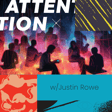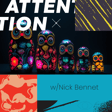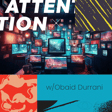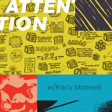Become a Creator today!Start creating today - Share your story with the world!
Start for free
00:00:00
00:00:01

The Two Channel Rule (& How It Can Simplify Your Life)
In this episode, Dan Sanchez talks abou t how the two channel rule has changed the game for his audience growth and why you should be serious about dropping all other channels but two.
Transcript
Introduction to Buyer Attention Strategies
00:00:04
Speaker
Welcome back to the Attention Podcast, where you learn how to gain and retain the attention of your buyers to grow an audience.
Why Focus on Two Marketing Channels?
00:00:11
Speaker
I'm Dan Sanchez with Sweetfish, and today I want to share a simple rule that will simplify your marketing life. It's a rule that many have stated that I've found to be true over and over again. The rule.
00:00:26
Speaker
You should only focus on two channels until they're successful. It's so hard, right? In this episode, I want to break down why that is, which two to focus on, and how to deal with the rest.
Marketers' Biggest Struggle: Resource Constraints
00:00:40
Speaker
So let's start with why.
00:00:42
Speaker
It's all about focus. In the B2B growth show, we surveyed, and when I say surveyed, I mean like, interviewed, face-to-face interviewed, 100 B2B marketing leaders. And one of the questions we asked was, what's the biggest struggle you and your team are facing this quarter?
00:01:02
Speaker
Overwhelmingly, the biggest struggle across marketing teams was a lack of focus. And they all said it different ways. Some of them talked about not having enough resources. Some of them talked about not having enough time, not enough talent, trying to accomplish too much, lack of clarity, prioritization.
00:01:20
Speaker
But ultimately it all comes down to a lack of focus of what's important.
The All-In Investment Approach
00:01:25
Speaker
Trying to accomplish too much with too little. And therefore everything gets minimal attention and everything suffers. The truth is, growing an audience takes an extreme amount of focused work.
00:01:40
Speaker
You cannot be successful only going in 50%. Even 80% can be difficult to get results with a specific channel. You have to be all in with all your effort, a lot of your budget, and a lot of your talent just focused on driving the success of even one channel. It's almost impossible to sprinkle that attention and that budget and that talent.
00:02:00
Speaker
across all the channels. And it's getting increasingly harder to stay focused because there's so many voices saying, oh do this, do that, tick tock, new things, flashy, squirrel, squirrel. They're everywhere, trying to pry our attention away. So by limiting it to two channels, you increase your odds of gaining
Advantages of Different Content Forms
00:02:18
Speaker
traction. And that's why the two channel rule works. So you might be thinking right now, well Dan, why two channels? If the goal is focus, why not just focus on one? Why do we even need two?
00:02:30
Speaker
And to that end, I have to say different channels have different distinctives. For the case of Sweetfish, we rock it with LinkedIn and podcasting. Podcasting and LinkedIn. Podcasting gives us the chance to form deep relationships with the guest and he's getting deep, meaningful content. I mean, your long form content, 40, 50 minute episodes sometimes.
00:02:52
Speaker
as well as creating the short form content that thrives best on LinkedIn. And it's not that I can't post long form content on LinkedIn, I can. They can take articles, they can take long live videos, they can take probably some longer videos if I posted it straight to my timeline.
00:03:07
Speaker
But we all know that kind of content just doesn't do well on LinkedIn. The shorter stuff works. And it's not as short as tweet size, but it certainly only takes a minute or two to consume versus a podcast where it takes 30 minutes to an hour to consume, depending on how fast you listen to podcasts.
00:03:23
Speaker
There's definitely a short form and a long form component going on. The two work better together. Oftentimes you end up using the short form to even promote your long form. Podcast doesn't have great discoverability. LinkedIn has great discoverability. They form different habits with the people that are using them to just get the content out or to view the content or to listen to the content or read or watch the content. Every channel forms different habits.
00:03:48
Speaker
Some channels are for quick consumption, and some channels are for long consumption. So you generally have channels that are for long form content, channels that are for short form content. Of course, it's a range with many in between, but I like to group them into short form and long term. With Twitter, LinkedIn, TikTok, and Facebook being some of the most popular short form content, or at least where short form content thrives, because they can all serve like long form to some degree.
00:04:16
Speaker
And then blogs, podcasts, YouTube are some of the places where a long form content thrives. The reason why you need two channels is because you need to have both a short form and a long form content channel to work synergistically together.
Choosing Your Two Focus Channels
00:04:33
Speaker
I know, I just threw out one of those marketing buzzwords, synergy. But that's what's going on. If you use one with the other, you get more out of both.
00:04:42
Speaker
So let's go into which one should you choose. There's so many options. Which should be your short form and which should be your long form. And to that I want you to consider these four questions to kind of narrow down which ones are best for you.
00:04:56
Speaker
So here's the questions. One, where does your audience spend their time? This is by far the most important question because it trumps all the other questions. All the other questions could come up with different answers. It doesn't matter. As a marketer, you gotta go where the attention of your audience is. And if they're on Twitter, then you better hammer Twitter. Chances are though, your audience could be across a couple different channels because they're on different ones. Here's the second question to bring more clarity.
00:05:23
Speaker
Which channels have the most traction already? Because if you already have traction on the channel and it's one of the many places your audience spends a lot of time on, then just keep doing that. You already have some success. It's easier to keep that ball rolling than to go start something new. Question number three, is which channels align better with your internal competencies?
00:05:43
Speaker
The makeup of your team might be different than what is needed for certain channels. You might have a team of great writers, so YouTube might not be the greatest channel to get started. You might have an awesome videographer on staff. So doing a blog might not be the best suited. Where do your competencies lie? Stick with those. And then four, which two are the most interesting to you? If you can't answer based on one of the three, and all is even, then just pick the two that your team is the most excited to go hit.
Strategic Channel Expansion
00:06:13
Speaker
Because honestly, that enthusiasm will carry you through the dry spots of trying to build either or both of them. If you're in the B2B marketing space, the two that I find get the best bang for your buck is LinkedIn and podcasting. But I could make an argument if you're really strong with video that Twitter and YouTube would go well too.
00:06:35
Speaker
TikTok and YouTube go well together for obvious reasons. What do you do with the rest of the channels? Because they matter too. And I still recommend setting up shop on every channel that comes out. You know, there's always going to be a new thing and you don't know if that new thing is going to be something you want in the future. So go set up an account, grab your permalink, grab your URL.
00:06:54
Speaker
upload your photo, and then just don't post anything to it. You don't need to link it to your website, but keep a record of all these channels you have somewhere so that if you do need it, it's there. It's ready. No one else has stolen your domain name or your URL yet. Those little vanity URLs are so important later on. Something I do like to do, other than just setting it up, is automating it.
00:07:15
Speaker
I noticed some very popular marketers, Seth Godin in particular, just automatically post every single blog post he writes to Twitter. And he says it even in the bio, hey, these are just automatically posted for my blog post. But if Twitter is the way you like to find out about my new blog, so be it. And you know what? It's honest. It's transparent. And some people do like to find out about it via Twitter. So why not?
00:07:40
Speaker
There's nothing wrong with automating to social. Just know that the returns on those social channels are going to be very minimal. But not a bad thing. It's actually a service to those who want to get the content dripped that way. But just be transparent that you're auto posting to these channels and all is well. So I like to auto post to most channels. Of course, my two is LinkedIn and podcasting where I'm not auto posting to. I'm writing everything from scratch and responding to all the comments. So lastly,
00:08:08
Speaker
How do you know when you're ready to graduate from the two to three? Well, how well are you doing with the two? Are you getting the results with the two? Are you driving revenue? Are people showing up in your sales pipeline saying, I found out about you through this channel or through this channel? And has it been going for a while? Do you have a rhythm for posting there that continue to execute at that rhythm while you spin up the new channel?
00:08:35
Speaker
If you have success, if you're getting sales from it and there's a rhythm to it, a process, someone dedicated to making sure this channel's a success or both channels a success, and you could start putting new resources to the third channel and only the third channel, then go ahead and activate the third channel. But only after you've gotten measurable success that you're happy with.
00:08:57
Speaker
There's a process in place and someone dedicated to making sure that channel doesn't tank while you're launching the third channel. And you can do that channel by channel. Go activate one of those channels you've been automating or just sitting dormant. It's time. And that is the two channel rule. It has been fundamental for me because I was one of those marketers trying to get all the channels going when really you just want to focus on two.
















